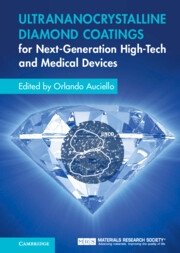Book contents
- Ultrananocrystalline Diamond Coatings for Next-Generation High-Tech and Medical Devices
- Ultrananocrystalline Diamond Coatings for Next-Generation High-Tech and Medical Devices
- Copyright page
- Contents
- Contributors
- Preface
- 1 Fundamentals on Synthesis and Properties of Ultrananocrystalline Diamond (UNCD™) Coatings
- 2 Ultrananocrystalline Diamond (UNCD™) Film as a Hermetic Biocompatible/Bioinert Coating for Encapsulation of an Eye-Implantable Microchip to Restore Partial Vision to Blind People
- 3 Science and Technology of Ultrananocrystalline Diamond (UNCD™) Coatings for Glaucoma Treatment Devices
- 4 Science and Technology of Novel Integrated Biocompatible Superparamagnetic Oxide Nanoparticles Injectable in the Human Eye and External Ultrananocrystalline Diamond (UNCD™)-Coated Magnet for a New Retina Reattachment Procedure
- 5 Science and Technology of Biocompatible Ultrananocrystalline Diamond (UNCD™) Coatings for a New Generation of Implantable Prostheses
- 6 Science and Technology of Novel Ultrananocrystalline Diamond (UNCD™) Scaffolds for Stem Cell Growth and Differentiation for Developmental Biology and Biological Treatment of Human Medical Conditions
- 7 New Generation of Li-Ion Batteries with Superior Specific Capacity Lifetime and Safety Performance Based on Novel Ultrananocrystalline Diamond (UNCD™)-Coated Components for a New Generation of Defibrillators/Pacemakers and Other Battery-Powered Medical and High-Tech Devices
- 8 Science and Technology of Integrated Nitride Piezoelectric/Ultrananocrystalline Diamond (UNCD™) Films for a New Generation of Biomedical MEMS Energy Generation, Drug Delivery, and Sensor Devices
- 9 Science and Technology of Integrated Multifunctional Piezoelectric Oxides/Ultrananocrystalline Diamond (UNCD™) Films for a New Generation of Biomedical MEMS Energy Generation, Drug Delivery, and Sensor Devices
- 10 Biomaterials and Multifunctional Biocompatible Ultrananocrystalline Diamond (UNCD™) Technologies Transfer Pathway
- Index
- References
3 - Science and Technology of Ultrananocrystalline Diamond (UNCD™) Coatings for Glaucoma Treatment Devices
Published online by Cambridge University Press: 08 July 2022
- Ultrananocrystalline Diamond Coatings for Next-Generation High-Tech and Medical Devices
- Ultrananocrystalline Diamond Coatings for Next-Generation High-Tech and Medical Devices
- Copyright page
- Contents
- Contributors
- Preface
- 1 Fundamentals on Synthesis and Properties of Ultrananocrystalline Diamond (UNCD™) Coatings
- 2 Ultrananocrystalline Diamond (UNCD™) Film as a Hermetic Biocompatible/Bioinert Coating for Encapsulation of an Eye-Implantable Microchip to Restore Partial Vision to Blind People
- 3 Science and Technology of Ultrananocrystalline Diamond (UNCD™) Coatings for Glaucoma Treatment Devices
- 4 Science and Technology of Novel Integrated Biocompatible Superparamagnetic Oxide Nanoparticles Injectable in the Human Eye and External Ultrananocrystalline Diamond (UNCD™)-Coated Magnet for a New Retina Reattachment Procedure
- 5 Science and Technology of Biocompatible Ultrananocrystalline Diamond (UNCD™) Coatings for a New Generation of Implantable Prostheses
- 6 Science and Technology of Novel Ultrananocrystalline Diamond (UNCD™) Scaffolds for Stem Cell Growth and Differentiation for Developmental Biology and Biological Treatment of Human Medical Conditions
- 7 New Generation of Li-Ion Batteries with Superior Specific Capacity Lifetime and Safety Performance Based on Novel Ultrananocrystalline Diamond (UNCD™)-Coated Components for a New Generation of Defibrillators/Pacemakers and Other Battery-Powered Medical and High-Tech Devices
- 8 Science and Technology of Integrated Nitride Piezoelectric/Ultrananocrystalline Diamond (UNCD™) Films for a New Generation of Biomedical MEMS Energy Generation, Drug Delivery, and Sensor Devices
- 9 Science and Technology of Integrated Multifunctional Piezoelectric Oxides/Ultrananocrystalline Diamond (UNCD™) Films for a New Generation of Biomedical MEMS Energy Generation, Drug Delivery, and Sensor Devices
- 10 Biomaterials and Multifunctional Biocompatible Ultrananocrystalline Diamond (UNCD™) Technologies Transfer Pathway
- Index
- References
Summary
This chapter describes the science and technology to develop extremely biocompatible UNCD coatings for encapsulation of devices to treat the glaucoma condition, related to clogging of natural tubes in the human eye’ trabecular mesh, which continuously drain the eye’ fluid from the inner part to keep the internal eye pressure constant. Clogging of the tubes produce overpressure in the eye, resulting in the destruction of the optical nerve and blindness. Two types of devices are being developed by the authors of this chapter, namely: 1) Hydrophobic (no eye fluid adsorption) UNCD coating on commercial polymer-based drain valves (hydrophilic-eye’ fluid adsorption), to practically eliminate attachment of proteins on hydrophilic polymer surface, thus fibrosis that reduce implant lifetime. 2)The second device consists of a novel metallic multi-hole circular grid, made of Ti, coated with a UNCD film and implanted in the eye’ trabecular region, providing efficient drainage of the eye’ fluid through the many holes existing in the structure. The UNCD-coated grid provides a smaller, less intrusive and more efficient device for treatment of glaucoma than the current commercial much larger valves based on polymers, which exhibit extensive biofouling.
Keywords
- Type
- Chapter
- Information
- Ultrananocrystalline Diamond Coatings for Next-Generation High-Tech and Medical Devices , pp. 107 - 120Publisher: Cambridge University PressPrint publication year: 2022



